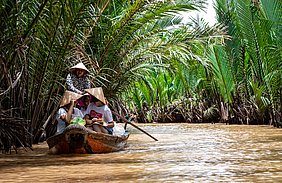TZW's work focused on the development and demonstration of a concept for the disinfection of bank filtrate under difficult conditions at two locations on the Cãu River and Red River in the greater Hanoi area. New methods for disinfection were used on a pilot scale (electrochlorination, stable chlorine dioxide, UV).
In this project, TZW focused on the following areas: Characterization of bank filtrate using various analytical methods; testing of a device developed by project partner bbe Moldaenke (bbe Quadra-Spec AquaScan) for the determination of algae-borne chlorophyll; development of methods for the spectroscopic determination of residual levels of disinfectants (free chlorine, chlorine dioxide) and monochloramine; analytical monitoring of pilot plants operated by project partners Autarcon (disinfection with chlorine) and a. p.f (disinfection with chlorine dioxide) at sites in Germany (Kassel, Dresden) and Vietnam (Bac Ninh).
The focus of this sub-project was on disinfection. The aim is to achieve safe disinfection that is microbiologically effective but at the same time minimizes the formation of undesirable disinfection by-products. The analytical monitoring of the Autarcon and a.p.f. pilot plants included the recording of parameters relevant to disinfection. This included the determination of ammonium, iron and manganese as well as disinfection by-products such as chlorite, chlorate and trihalomethanes.

![[Translate to English:] Prüfstelle-Produktprüfung_Teststand Test centre and product testing](/fileadmin/_processed_/0/9/csm_TZW-Karlsruhe_Pruefung_Geraete-Teststand_377188946c.jpg)
























